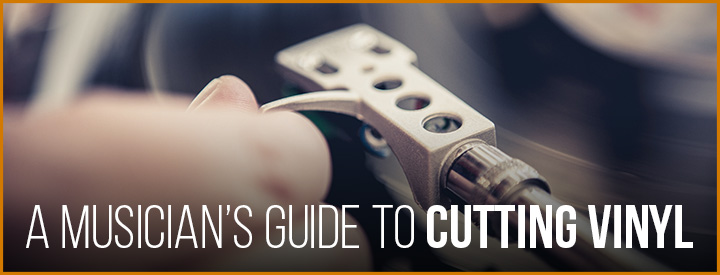A Musician’s Guide to Cutting Vinyl
For many people media exists in a “cloud” somewhere, and music has become a sort of sonic wallpaper. It’s something to consume while working out, driving or waiting for the subway. But the cult of vinyl is strong. Oddly enough, it’s the last physical medium that’s seeing an increase in sales: a little shy of 10 million units last year, an increase of 52% from the previous year, according to Nielsen Soundscan. All over the country you can find thrift stores with record sections, LPs and 45s at the CD shop, and even major chain stores like Urban Outfitters are getting in on the action.
Many of vinyl’s champions point to “superior quality” as their motivation for buying records. But compared to the resolution and quality available digitally, it’s technically a “lossy” format, though not in the same way as an MP3. What the enthusiasts are referring to is the user experience. Many of us are are in search of something that’s real, tangible and authentic, and vinyl gets us there.
The vinyl listening experience is different. It’s an event. When you put a record on, you have to be present. Records must be tended to, like a fire in a hearth, and so vinyl draws you in. It’s an experience, and there’s something hypnotizing about watching that needle dance across the surface of the album.
All that being said, more bands are looking to vinyl to help them move units, to which I say: “Go for it.” But there are a number of limitations and peculiarities of the medium that need to be considered.
Timing and Track Order
Runtime is a big issue on vinyl. You have about 18 minutes per side to play with, and structuring the tracklist is more involved than establishing artistic order. As you cut in on a side of vinyl, the distance to the center of the disc decreases. That means the same amount of sonic information gets stored in less space. As a result, inner cuts tend to have more harmonic distortion, and they lose about 3db at around 15khz. At this point, the tone arm is at an odd play angle and will not respond optimally to dynamic cuts in volume or the frequency spectrum. It’s not a coincidence that when you look at vinyl albums, you tend to find the higher-energy cuts in the first few tracks and the ballads on the inner tracks on each album side.
Mastering Concerns
In many cases you cannot press the same master to vinyl, iTunes, Spotify, Soundcloud, Bandcamp, etc. A well-done master may be ripe to be sent to the lathe, but a number of digital conveniences that have become the norm will not translate to vinyl.
The wide dynamic stereo cuts that we see in many modern mixes are not possible to cut on a vinyl pressing. A track that has phase issues in the low-end, which may not be problematic on digital playback, can wreak havoc on a cutting head. And the cutting head may not be able to interpret out-of-phase low end and could just bind up instead.
Certain frequency boosts can aggravate the cutting head and cause problems in playback or reproduction. Conversely, active and rapid high-end transients literally will cause “rapids” in the cuts and lead to playback and skipping issues. Additionally, loud and dynamic tracks take up more physical space on the album, and reducing those elements to preserve space can raise the relative noise floor of the album.
Playback Idiosyncrasies
Digital has about a 26dB advantage over vinyl with respect to dynamic range, and at least a 40 to 50 dB advantage in stereo separation as well, with no deviation in pitch or speed. Additionally, every element in the chain of a vinyl playback system imparts a tone. From your choice of cartridges, amplifiers and speakers, each of these components impart a certain EQ of its own. While this may not be a problem per se, it does alter the listening experience on a system-by-system basis. Part of this is the charm of vinyl, an album may sound slightly different at your place than at a friend’s, highlighting a certain part of the mix over another. All of these are just things to consider before hopping on the vinyl wagon.
These are just a few of the many things to consider before deciding to cut your next album to vinyl. As a playback medium, most industry professionals would agree that vinyl is not a better format than the others available; it’s just different. There’s something to be said for listening to music as a social experience. The idea of laying albums out on the floor in front of your system as you peruse the album art and liner notes and listen to a work of art transforming the air in front of you — from the vibrations of a physical object — is kind of romantic. Liking vinyl may make you a hipster, but that’s not necessarily a bad thing, either.
FONTE: https://reverb.com/news/a-musicians-guide-to-cutting-vinyl
Julian Ludwig é diretor do Pro Áudio Clube, produtora de áudio Jacarandá, Loc On Demand e Jacarandá Licensing. Trabalhou para empresas como: Guaraná Antartica, TV Gazeta, NET, Chivas Regal, FNAC, Prefeitura de São Paulo, Mukeca Filmes, Agência LEW’LARA TBWA, Agencia MPM, Agência Content House entre outras. Fez trilhas para programas de TV como: Internet-se (Rede TV), Você Bonita (TV Gazeta), Mix Mulher (TV Gazeta), Os Impedidos (TV Gazeta), Estação Pet (TV Gazeta), CQC (TV Band) Vinheta Oficial TV Gazeta, entre outras. Também atuou em vários longas e curtas metragens, incluindo mixagem em 5.1 e serviços de pós-produção.

